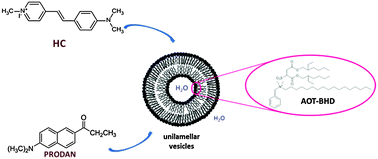Singularities in the physicochemical properties of spontaneous AOT-BHD unilamellar vesicles in comparison with DOPC vesicles†
Abstract
In the present work, we study different physicochemical properties of the spontaneous unilamellar vesicles created by the catanionic ionic liquid-like surfactant benzyl-n-hexadecyldimethylammonium 1,4-bis-2-ethylhexylsulfosuccinate (AOT-BHD), using two different fluorescent probes: 6-propionyl-2-(dimethylaminonaphthalene), PRODAN and trans-4-[4-(dimethylamino)-styryl]-1-methylpyridinium iodide, HC. Steady-state and time resolved fluorescence emission spectroscopy allowed us to find the unique properties of the AOT-BHD bilayer in comparison with vesicles formed using the traditional phospholipid 1,2-di-oleoyl-sn-glycero-3-phosphatidylcholine, DOPC. From the emission results, we observed that the region of the bilayer close to the polar head of AOT-BHD is a powerful electron donor environment, even larger than DOPC. Additionally, the AOT-BHD bilayer offers a less polar and slightly more viscous zone than DOPC. Thus, this particular bilayer is able to produce large incorporation of ionic and nonionic molecules and is very promising to be used as a nanocarrier in pharmacological, cosmetic and food fields.


 Please wait while we load your content...
Please wait while we load your content...